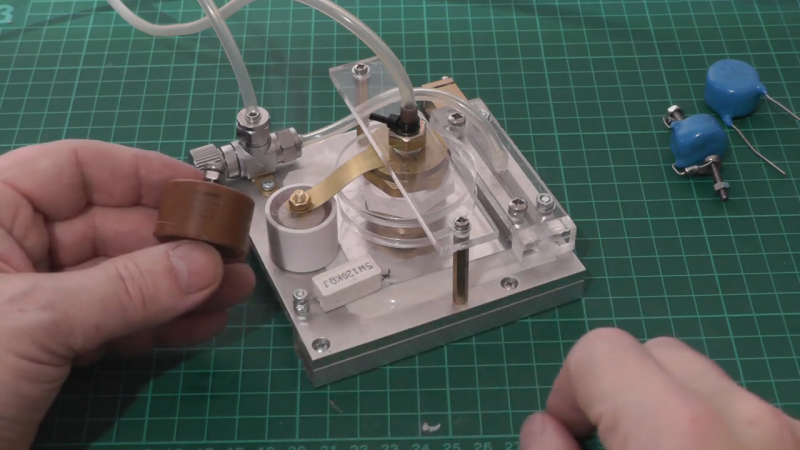Mouser and Digi-Key are great for servicing most needs, and the range of parts they offer is frankly bewildering. But given the breadth of the hardware hacking community’s interests, few companies could afford to be the answer to everyone’s needs.
That’s especially true for the esoteric parts needed when one’s hobby involves high voltages and homemade lasers, like [Les Wright]. He recently came up with a DIY doorknob capacitor design that makes the hard-to-source high-voltage caps much easier to obtain. We’ve seen [Les] use these caps in his transversely excited atmospheric (TEA) lasers, a simple design that uses high-voltage discharge across a long, narrow channel filled with either room air or nitrogen. The big ceramic caps are needed for the HV supply, and while [Les] has a bunch, they’re hard to come by online. He tried a follow-up using plain radial-lead ceramic capacitors, and while the laser worked, he did get some flashover between the capacitor leads.
[Les]’s solution was to dunk the chunky caps in acetone for a week or so to remove their epoxy covering. Once denuded, the leads were bent into a more axial configuration and soldered to brass machine screws. The dielectric slug is then put in a small section of plastic tubing and potted in epoxy resin with the bolts protruding from each end. The result is hard to distinguish from a genuine doorknob cap; the video below shows the build process as well as some testing.
Hats off to [Les] for taking pity on those of us who want to replicate his work but find ourselves without these essentials. It’s nice to know there’s a way to make unobtanium parts when you need them.
















Very neat. Only taken caps apart by massively and suddenly over volting them. Not generally useful afterwards :)
After reading the title, I was wondering why a person who is expecting a Digi-Key delivery would want to put high voltage on their front door knob.
B^)
Perhaps to stop all of them pesky Amazon deliveries?
We haven’t seen Jehovah’s Witnesses since that fateful day …
I would not count that as a loss :-)
This is a very cool demonstration, and possibly useful to hackers.
I have to ask, though: Axial doorknob capacitors are easy to get on eBay. A quick search finds several at about the same capacitance and voltage rating that he’s using. A sample below is 30kV @1000pf for about $10.
Is there a problem with just getting them from eBay? Are the DigiKey ones so cheap to warrant all the extra effort?
https://www.ebay.com/itm/1-X-1000pF-20-4kV-30kVAR-Doorknob-Capacitors-K15Y-1/183442309316?hash=item2ab60380c4:g:oisAAOSwHUlbogPx
I read there’s an ITAR restriction on doorknob capacitors, so they may be more available in the US rather than elsewhere.
The capacitors in PWalsh’s link are in Romania…
A cursory search of English feeBay finds new 30kV doorknob caps for sale from Russia, Sweden, Ukraine, China, Greece, Bulgaria and of-course the USA. So I think that covers most of the political blocks and makes ITAR a non-issue for non-Americans (and points out how mostly-stupid it is, IMHO).
Be careful with the ratings on these. This is only rated for 4kV The kVAR rating is reactive power.
Some people have found 1000pf @ 3okV quite pricey. In the UK I can get them for about 50 bucks delivered, and that can kill your budget fast. Wire ended caps are dirt cheap.
Les
One of the first links from Aliexpress: https://www.aliexpress.com/item/1005001885074804.html
Great to watch being made and used!
Why not use Eutectic Silver bearing solder? OK, its Tin/Lead based, but with the silver content it will not leach the silver plating from the ceramic.
Sn-Cu-Ag has a reasonable melting temperature and can be easily bought.
Agreed!
I have already tried silver paint to repair these which works ok, and I am looking into conductive epoxy as a possibility as well.
The coatings are way thin and I suspect the manufacturer uses a lsolder like you describe as well.
Cheers!
Being lazy, I’d just dunk them in a tub of mineral oil.